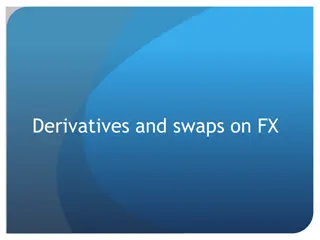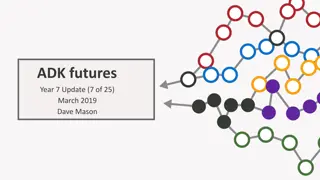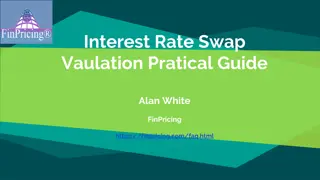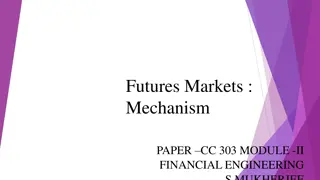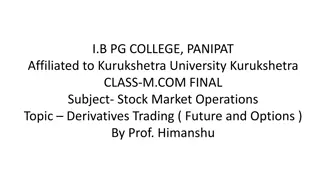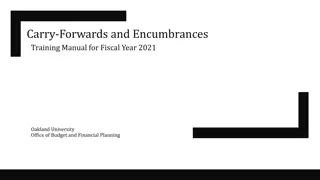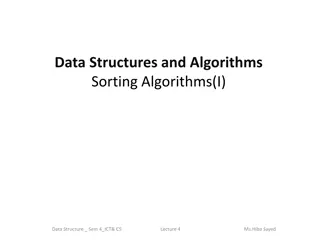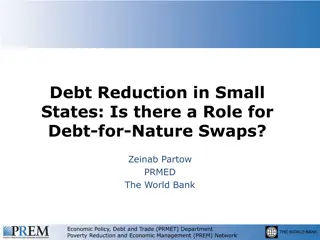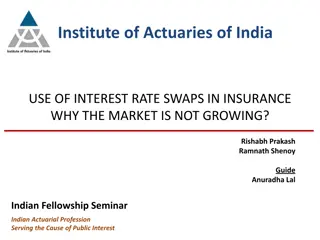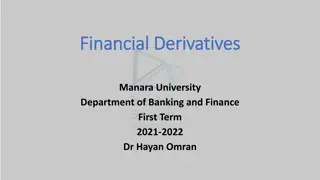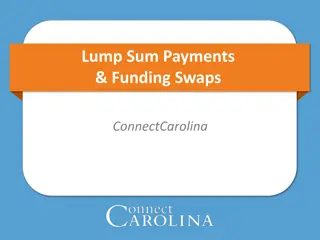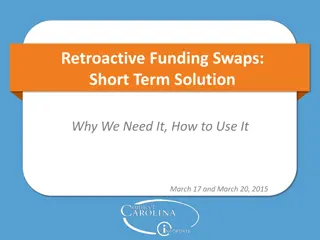Understanding Forwards, Futures, and Swaps in Investment Finance
Dive into the world of investments with a detailed analysis of forwards, futures, and swaps. Discover how these derivatives work, their key characteristics, and practical examples of how they are utilized for hedging and risk management in the financial markets.
Download Presentation

Please find below an Image/Link to download the presentation.
The content on the website is provided AS IS for your information and personal use only. It may not be sold, licensed, or shared on other websites without obtaining consent from the author. Download presentation by click this link. If you encounter any issues during the download, it is possible that the publisher has removed the file from their server.
E N D
Presentation Transcript
Chapter 14 An Analytical Approach to Investments, Finance and Credit Derivative Investments: Futures, Forwards, Swaps, Swaptions, CDAs, FRAs, and Other Derivatives
Forwards, Futures Swap Contracts: Overview The main difference between option contracts, described in the previous chapter, and other derivatives such as forwards and futures contracts, is that the buyer of an option pays upfront to obtain the right to exercise the option in the future and buy or sell the underlying stock. In the case of forward and future contracts, the parties are both obliged to sell or buy from each other on a specific date for a specific price. Swaps are also different than options as they are contracts in which the parties agree to exchange cash flows based on a set interest and currency rate today. Forwards, futures, and swaps are types of securities that are derived by the direction of other securities such as interest rates, currency rates, commodity prices, or index levels. When comparing contracts between options and futures, it is important to note that they have the same input characteristics including a future price (letters X in options and K in futures), an underlying asset such as a stock or commodity (both represent letter S for stock and spot for options and futures, respectively), and an expiration date (delivery day for forwards). The difference is the obligation that comes with future contracts, as well as the fact that options contracts carry a premium (p) while futures and forwards do not.
Forwards: Overview A forward contract is a private and highly customized contract between two parties to buy or sell a specific asset at a pre-agreed price on a specific future date. Typically, these contracts are between large institutions; the public does not usually get involved in these forward transactions. However, they can access these types of opportunities in the futures market. The terms and conditions of a forward contract will include the description of the asset such as the specific commodity, the price of the asset, the delivery date, and the volume to be traded. Forwards are used primarily for hedging purposes. Typical forward contracts are usually on commodities that could include precious metals, agricultural products, and natural gas and oil. A forward contract settlement can occur on a cash or delivery basis. The cash basis is receiving or paying the difference between the future price and the spot price. The delivery basis is paying for receiving the delivery of the actual asset and receiving payment if you deliver the asset to the buyer.
Forwards: Overview - Example Assume a farmer who produces wheat sells his stock primarily to a local bread company. This farmer s cash flow is primarily dependent on wheat prices. The farmer knows the market prices for wheat will tend to fluctuate from the time the farmer harvests the wheat until it is delivered it to the bread company. The farmer, wanting to secure his revenues, looks for a way to ensure the amount he ll receive for his inventory. This could be especially important for the farmer if he has debt payments such as a mortgage on his farm or leases on his equipment. Securing his revenue is essential if he wishes to predict what he can pay toward his loans and still profit in order to stay in business. In this case, the farmer will seek to enter a contract with the bread company to lock in the delivery price, volume, and date for his sale. Along the same lines, the bread company oddly enough is faced with the same problem as the farmer. The bread company needs to lock in its expenses in order to accurately predict its profit. For the bread company, wheat cost represents the highest and potentially variable cost component in its income statement.
Forwards: Overview - Example The forward contract between the wheat farmer and the bread company will include the volume, price, date, volume, and will be delivered as follows: Buyer: Bread company Seller: Wheat Farms Inc. Volume: One million bushels Price: $4.45 Delivery date: 03/15/20xx (6 months from today) Two different views: The seller is concerned about a potential decline in the price of wheat; and the buyer is concerned that the wheat s prices will increase by the time one million bushels of wheat is delivered. With the contract in place, no matter what happens to wheat prices the seller is promised to be paid $4.45 per bushel or $4.45 million and the buyer is obliged to pay $4.45 per bushel or $4.45 million on delivery date as the one million bushels are satisfied.
Forwards: Overview - Example This contract can also be done with a financial institution on a cash basis to hedge the farmer s position as a derivative to wheat s current spot price. In this case, the farmer signs a short price contract because he is hedging against a decline in wheat prices. The bread company can also reach out to a financial institution to hedge its cost via a derivative forward contract. In this case, the bread company signs a long contract since it is hedging against any increase in price. Both contracts (direct) between the farmer and the bread company and indirect derivative contract between the parties, separately, as well as the financial institutions, are illustrated in figure 14.1.
Forwards: Overview - Example FORWARD CONTRACTS Direct Contracts and Indirect Derivative Contracts Both contracts (direct) between the farmer and the bread company and indirect derivative contract between the parties, separately, as well as the financial institutions, are illustrated in figure 14.1. DIRECT PRIVATE FORWARD CONTRACT BETWEEN TWO PARTIES (Not using the financial institution) BUYER: SELLER: VOLUME: PRICE: TOTAL COST DATE: TYPE: Bread Company Wheat Farms Inc. 1,000,000 $ 4.45 per bushel 4,450,000 $ 3/15/20XX Delivery Basis bushels (6 months) Bread Company Wheat Farms Inc. 3/15/20XX 3/15/20XX 4,450,000 Income Statement Revenues Cost of Goods Sold - Wheat Expenses Income Statement Revenues Cost of Goods Sold - Wheat Expenses (4,450,000) For the derivative contract between the parties and the financial institutions, the parties will pay or receive the contract depending on the spot price upon expiration day. Figure 14.1 shows three possibilities of the wheat spot price at expiration day. INDIRECT (DERIVATIVE)FORWARD CONTRACT BETWEEN EACH PARTY (LONG & SHORT) WITH FINANCIAL INSTITUTION PARTY A LONG: CONTRACT: VOLUME: NO OF CONTRACTS: PRICE: EXP. DATE: TYPE: PARTY B SHORT: CONTRACT: VOLUME: NO OF CONTRACTS: PRICE: EXP. DATE: TYPE: Bread Company 5,000 1,000,000 200.00 $ 4.45 3/15/20XX (6 months) Cash Basis Wheat Farms Inc. 5,000 1,000,000 200.00 $ 4.45 3/15/20XX (6 months) Cash Basis bushels bushels (1,000,000/5,000) bushels bushels (1,000,000/5,000) Bread Company Wheat Farms Inc. WHEAT PRICES ON DELIVERY DAY WHEAT PRICES ON DELIVERY DAY Transaction on Delivery/Expiration Day Transaction on Delivery/Expiration Day -$ 0.50 $ 3.95 $ 0.00 $ 4.45 -$ 0.50 $ 3.95 $ 0.00 $ 4.45 Increase/Decrease in Spot Prices Scenarios - Spot Prices Cost of Wheat Purchases at Spot Prices + Profit/Loss form Forward Contract Net Payment $ 0.50 $ 4.95 (4,950,000) 500,000 (4,450,000) Increase/Decrease in Spot Prices Scenarios - Spot Prices Revenue from Wheat Sales at Spot Price + Profit/Loss form Forward Contract Total Proceeds $ 0.50 $ 4.95 4,950,000 (500,000) 4,450,000 (3,950,000) (500,000) (4,450,000) (4,450,000) (4,450,000) 3,950,000 500,000 4,450,000 4,450,000 4,450,000 - - Fully Hedged Fully Hedged Figure 14.1
Forwards: Overview - Example If it s exactly $4.45 per bushel (contract price), no money is owed by the farmer or the bread company to the financial institution and the contract is closed. If the spot price is lower than the contract price ($3.95), the bread company will pay the lower price to buy the wheat in its course of doing business, but also pay the cash difference between the contract price and the spot price ($0.50 x 1 million bushels). The wheat company will receive lower revenues by its customers for selling wheat at $3.95 per bushel, or $3,950,000. However, it will make up the difference from the lower price by also receiving $500,000 from the derivative contract ($0.50 x 1 million bushels). At a higher spot price, the bread company will pay its suppliers $4,950,000, or 4.95 a bushel, but will receive $500,000 from the derivative contract to offset the higher prices. The farmer will receive higher revenues for selling his wheat at a higher spot price but will be asked to pay for the derivative contract, resulting in net proceeds of $4,450,000.
Forwards: Overview - Example This contract can also be done with a financial institution on a cash basis to hedge the farmer s position as a derivative to wheat s current spot price. In this case, the farmer signs a short price contract because he is hedging against a decline in wheat prices. The bread company can also reach out to a financial institution to hedge its cost via a derivative forward contract. In this case, the bread company signs a long contract since it is hedging against any increase in price. Both contracts (direct) between the farmer and the bread company and indirect derivative contract between the parties, separately, as well as the financial institutions, are illustrated in figure 14.1.
Risks with Forward Contracts The market for forward contracts is huge since many of the world s biggest corporations use it to hedge currency and interest rate risks. However, since the details of forward contracts are restricted to the buyer and seller and are not known to the general public the size of this market is difficult to estimate. The large size and unregulated nature of the forward contracts market makes it susceptible to a cascading series of defaults in the worst-case scenarios. While banks and financial corporations mitigate this risk by being very careful in their choice of counterparty, the possibility of large-scale default does exist.
Future Contracts: Commodities FUTURES MARKETS - EXCHANGE PRICE April AGRICULTURE Delivery Day (Future) May May May May May May May May May May May May Volume per Contract Future Price $ % Units Change Change Futures contracts have the same characteristics as forward contracts, with the exception being that futures trade in the exchange markets that the public can invest in. USD/MT USd/lb. Cents/bu. USd/lb. USd/lb. USd/lb. Cents/bu. USd/lb. USD/cwt Cents/bu. USd/lb. Cents/bu. 2,342.00 92.85 364.50 78.37 94.23 121.50 279.50 109.80 10.69 891.75 12.77 441.25 (30.00) (0.05) (2.75) 0.10 (2.52) (1.17) 1.25 (0.35) 0.02 (2.50) (0.21) (7.00) -1.26% -0.05% -0.75% 0.13% -2.61% -0.96% 0.45% -0.32% 0.14% -0.28% -1.62% -1.56% Cocoa (ICE) Coffee 'C' (ICE) Corn (CBOT) Cotton #2 (ICE) Lean Hogs (CME) Live Cattle (CME) Oats (CBOT) Orange Juice (ICE) Rough Rice (CBOT) Soybean (CBOT) Sugar #11 (ICE) Wheat (CBOT) 112,000 10 37,500 5,000 50,000 40,000 40,000 5,000 15,000 2,000 60,000 5,000 Precious Metals & Industrial Metals Delivery Day (Future) May May May May Volume per Contract $ % Units Price Change Change USD/MT USD/lb USD/t oz. USD/t oz. 6,476.00 291.10 1,277.50 15.06 (80.00) (1.55) 1.50 0.02 -1.22% -0.53% 0.12% 0.11% Aluminum (LME) Copper (Comex) Gold (Comex) Silver (Comex) 25 25,000 100 5,000 Most transactions are on a cash basis but there is an option, rarely used, to receive the actual delivery of the asset. Energy Volume per Contract $ % Delivery Day May May May May Units Price Change 2.23 4.26 0.03 1.75 Change 3.10% 2.06% 1.24% 2.73% USD/bbl. Cents/gal. USD/MMBtu USD/bbl. 74.20 211.35 2.52 65.75 Brent Crude (ICE) Heating Oil (Nymex) Natural Gas (Nymex) WTI Crude Oil (Nymex) 1,000 42,000 10,000 1,000 Figure 14.2 shows the future trading prices (expiring 1 or 2 months from today). Interest Rate Funds Volume per Contract $ % Delivery Day June June June May May Units Price Change 15.00 12.50 6.50 0.01 Change 0.10% 0.25% 1.24% 0.00% 0.00% pts 32nds of 100%. pts 32nds of 100%. pts 32nds of 100%. Daily Avg pts of 100% 145-080 122-050 114-195 97.60 97.49 Treasury Bonds (CBT) Treasury Notes (CBT) 5-yr Tresury Notes (CBT) 30-Day Fed Funds (CBT) 1-Month Libor (CME) 100,000 100,000 100,000 5,000,000 3,000,000 - Currency Futures Volume per Contract $ % Delivery Day June June June Units Price Change 0.001 0.011 Change 0.00% 0.14% 0.95% $ per 100 $ per CAD $ per 97.2900 0.7351 1.1523 - Japanese Yen (CME) Canadian Dollar (CME) Euro (CME) 12500000 100,000 125,000 Index Futures Volume per Contract $ % Delivery Day June June June Units Price Change 19.20 40.00 8.10 Change 0.77% 0.63% 0.60% $USD x Index $USD x index $USD x index 2,505.20 6,333.30 1,349.00 S&P 500 Index (CME) Mini Nasdaq 100 (CME) Mini Russel 2000 (CME) 250 20 50 Figure 14.2
Future Contracts: Commodities Typically, the future markets are divided into five major commodity sections: agriculture, precious metals and industrial metals, energy, currency futures, and index futures. Each asset also has a customized number of units per contract. For example, figure 14.2 shows that Silver s one contract is 5,000 troy ounces, so buying the Silver futures at $15.06 per troy ounce will cost $75,300. The brokers will ask the investor to deposit 10% of that amount, or $7,530 (initial margin), and at expiration day, the settlement will be set up on cash basis and will be expected to be paid or the difference received between the original future price and current price, which should converge to the spot price on delivery day. A delivery basis contract gives the investor the right to buy 5,000 ounces at $15.06, no matter what happens to the price.
Future Contracts: Commodities There are two following reasons for the investor to enter a futures contract: Speculation: This is when investors enter futures contracts if they believe the underlying asset such as a commodity price, interest rate, or market index will increase or decrease based on specific events. If the investor anticipates an increase in the price of an underlying asset in the future, he or she could potentially profit by purchasing the asset at a set price via entering a futures contract and selling it later at a higher price in the spot market through cash settlement. However, if the underlying asset declines, he or she could lose the difference between the future price they locked in and the spot price. Hedging: The purpose of hedging, like the example used in the forward contract, is not to profit from any favorable price movements but to prevent losses from selling or buying the underlying asset as a course of business (see example of the farmer and wheat companies shown previously in figure 14.1).
Future Contracts: Commodities For an investor to set up a futures contract account, most brokers will ask the investors to deposit 10 15% of the potential delivery amount (future price x volume) times the number of contracts. Precious Metals & Industrial Metals Volume per Contract 25,000 5,000 Delivery Day (Future) May May May May $ % Units Price Change Change USD/MT USD/lb USD/t oz. USD/t oz. 6,476.00 291.10 1,277.50 15.06 (80.00) (1.55) 1.50 0.02 -1.22% -0.53% 0.12% 0.11% Aluminum (LME) Copper (Comex) Gold (Comex) Silver (Comex) 25 100 Daily Mark-to-Market - 5/15/20xx USD / Unit Contract contract Deposit (Initial Invest.) (7,530) Futures Price Profit (loss) per ounce 10% Day Balance Profit HPR% The prices are settled every day and a mark to market tracks the account to see if the investor needs to deposit additional funds to cover the original margin (10 15%). Figure 14.3 shows an example of the original deposit and the mark-to- market daily settlement until expiration Balance * 5/10 5/11 5/12 5/15 5/16 5/17 5/18 5/19 5/22 5/23 Wednesday Today Thursday Friday Monday Tuesday Wednesday Thursday Friday Monday Tuesday $ $ $ $ $ $ $ $ $ $ 15.06 16.06 16.31 16.01 15.85 15.95 15.51 15.65 16.00 16.40 7,530 8,530 9,030 7,530 6,730 7,230 5,480 6,180 7,430 9,180 75,300 $ $ $ $ $ $ $ $ $ 0.20 0.10 (0.30) (0.16) 0.10 (0.35) 0.14 0.25 0.35 sum= 1,000.00 500.00 (1,500.00) (800.00) 500.00 (1,750.00) 700.00 1,250.00 1,750.00 1,650.00 Credit Credit Debit Debit Credit Debit Credit Credit Credit Delivery 1,650 21.9% Figure 14.3
Future Contracts: Commodities Measuring the Basis The basis is the difference between the futures price and spot price. In general, when the underlying asset s price moves up, the futures should move up as well. However, the movement could be inconsistent, potentially creating an arbitrage opportunity. Speculators can take advantage of this and speculate on the basis, which is the differential between the future price and the spot price K-S or S-K. The basis risk is the risk associated with imperfect hedging. Under these conditions, the spot price of the asset, and the futures price, do not converge on the expiration date of the future. The amount by which the two quantities differ measures the value of the basis risk.
Future Contracts: Commodities Measuring the Basis Example of speculating on the basis An investor is holding 100 ounces of gold, who is short one gold futures contract. Suppose that gold today (April) sells for $1,247 an ounce, and the futures price for May delivery is $1,277 an ounce, as shown previously in figure 14.3. Therefore, the basis is currently $30 ($1,277 - $1,247). Tomorrow, the spot price might increase to $1,257, while the futures price might increase to $1,282, so the basis narrows to $25 ($1282 - $1,257). The investor s gains and losses are as follows: Gain on selling of gold (per ounce) is $1,257 1,247 = $10 and loss on gold futures position (per ounce) is $1,282 1,277 = $5, which is used for hedging purposes, netting a gain of $5 per ounce.
Future Contracts: Commodities Optimal Hedge Ratio The hedge ratio is a measurement of the size of the position taken in futures contracts to the size of the exposure as follows: h = S K where is the correlation between the spot price (S) and the future price (K), S is the standard deviation of the spot price, and K is the standard deviation of the futures price. Example of using the optimal ratio A company knows that it will buy one million gallons of jet fuel in 3 months. The standard deviation of the change in the price per gallon of jet fuel over a 3-month period is calculated to be 0.032 (3.2%). The company chooses to hedge its market exposure by buying futures contracts on heating oil. The standard deviation of the change in the futures price over a 3-month period is 0.040 (4.0%) and the coefficient of correlation between the 3-month change in the price of jet fuel and 3-month change in the futures price is 0.8. The optimal hedge ratio is therefore h = S 0.040 = 0.64 One heating oil futures contract is on 42,000 gallons (see figure 14.3 under energy futures and heating oil showing 42,000 per contract). The company should therefore buy K = 0.80 0.032 0.64 x (1,000,000 / 42,000) = 15.2 contracts (~15 contracts).
Futures: Interest Rates The interest rate future contract is a contract between the buyer and seller (financial institution) agreeing to a set interest rate in the future. The interest rate future can be based on underlying assets such as treasury bills, fed funds, or the 1-month LIBOR traded on the Chicago Mercantile Exchange (CME). Interest rate futures are used mostly for hedging purposes and sometimes speculation purposes. They can be bought and sold on exchanges such as Intercontinental Exchange (ICE) Futures, Europe. Take treasuries, for example. Each future contract size for treasuries is $100,000. Each contract trades in handles of $1,000, but these handles are split into 30 seconds or increments of $31.25 ($1,000/32). Figure 14.2 shows the June 5-year treasury notes on a contract that is listed as 114-195. This means that the total price of the contract is the face value, plus one handle, plus 19.5/32s of another handle, or 19.5 32 122 5 price = $100,000 + 1,000 + 1,000 x = $101,609.37
Futures: Interest Rates Each futures contract party has a different view on interest rates and depending on its view it buys or sells futures contracts. The seller of the interest rate future contract is obliged to borrow money and pay interest. The buyer of the interest rate future contract is obliged to deposit money and has the right to receive interest. The price of a futures contracts is derived from the underlying rate of interest (spot rate) and fluctuates along with interest rates. Like bond prices, it is important to understand that as interest rates rise, the market price of futures contracts falls. For example: Let s assume that a particular futures contract allows borrowers and lenders to pay or receive interest at 3%, which is the current market rate of interest available. Let s assume interest rates increase by 1% to 4%. The 4% futures contract has become less attractive to buy because depositors can earn 4% at the market rate but only 3% under the futures contract. The price of the futures contract must fall. Also, borrowers will now have to pay 4%, but if they sell the future contract, they must pay only 3%, so the market will have many sellers, and this reduces the selling price until a buyer-seller equilibrium price is reached.
Futures: Interest Rates The hedging mechanism works as follows: An investor of a floating rate loan that earns interest is concerned that interest rates such as LIBOR will fall, thus reducing their income. If interest rates fall, futures prices will rise. If the investor is smart, he or she will buy futures contracts (long position) now and sell later. The gain on futures can be used to offset the lower interest earned. On the other hand, the borrower is concerned that interest rates will rise and increase his or her expense. If interest rates rise, futures prices will fall, so the borrower could sell the futures contracts now (short position) and buy later at the lower price.
Futures: Foreign Currency Rates The foreign currency future contract is a contract between the buyer and seller (financial institution) agreeing to a set specific currency rate in the future. The foreign currency future can be based on underlying assets such as the Japanese yen ( ,) Canadian dollar, European euros ( ) or any other foreign currencies. Currency futures are used mostly for hedging and speculation purposes and can be bought and sold on exchanges such as the Chicago Mercantile Exchange (CME). Each futures contract party has a different view on currency rates and depending on his or her view he or she buys or sell futures contracts. For example, Let s assume an importer of European goods is vulnerable to currency risk as he needs to convert the U.S. dollar to euros to pay for goods. In order to hedge his position, he buys (long) the euros at the current exchange rate of 1.15 $/ and locks it in (see figure 14.4). This importer is scheduled to receive a shipment that requires a 1 million equivalent payment, so he locks in the currency at 1.15x so the most he can pay is $1,150,000. Each futures contract is $125,000. For $1,150,000 he should buy eight contracts at the exchange rate of 1.15 ( 1,000,000/ 125,000 per contract).
Futures: Foreign Currency Rates Figure 14.4 shows the hedging helps the importer predict the payment at various scenarios of the exchange rate FUTURES and FORWARDS Currency Futures Volume per Contract 12500000 100,000 125,000 $ % Units Price Change Change 0.00% 0.14% 0.95% $ per 100 $ per CAD $ per 97.2900 0.7351 1.1523 - Japanese Yen (CME) Canadian Dollar (CME) Euro (CME) 0.001 0.011 Purhase Goods in = Lock in Exchange Rate - futures = 1,000,000 1.1523x EXCHANGE RATES $/ Transaction on Delivery/Expiration Day Contracts 0.10x 1.25x 1,252,300 (100,000) 1,152,300 0.00x 1.15x 1,152,300 1,152,300 Increase/Decrease in Spot Prices Scenarios - Spot Prices Cost of purhasing at the European good at the spot Prices + Profit/Loss form Forward Contract Net Payment for the European Goods -0.10x 1.05x 1,052,300 100,000 1,152,300 8 - Fully Hedged Figure 14.4
SWAPS - Interest Rates Swaps Interest rate swaps are contracts between two parties via a financial intermediary who agree to exchange (swap) one set of cash flows for another There are three different types of interest rate swaps: fixed to floating, floating to fixed, and float to float. Fixed to floating:For example, let s assume a company issued bonds at a fixed interest rate. The company's management feels that it can reduce the payments by entering into a swap agreement that swaps its fixed rate with a net floating rate supporting its view that rates will stay low for a while. In this case, the issuer of bonds can enter into a swap with a counterparty bank in which the company receives a fixed rate to offset its bond coupon payment and pay a floating rate. The swap is structured to match the maturity and cash flow of the fixed-rate bond and these two fixed-rate payments are netted. Floating to fixed: A company that is currently a borrower of a LIBOR floating rate loan and needs access to a fixed-rate loan because of concern that the rates will go up can enter a swap to achieve a fixed rate. Float to float: Companies sometimes enter into a swap to address different maturities that have different floating rates, known as a basis swap. A company can swap from 1e-month LIBOR to 3-month LIBOR because the rate is more attractive, or it matches other payment flows.
SAWPS - Interest Rates Swaps Interest Rate Swap Figure 14.5 shows an example of two parties with two different views on interest rates who seek advice from their investment advisor on how to use the swap market to get a better-priced loan. This is a case where two parties (A&B) have approached a bank to borrow a $100 million loan. The bank gives them a choice of fixed rate or floating rate, shown in figure 14.5. Company A Company B Fixed Rate Float (L+) IR View: Choose: 5.00% 0.30% Low Fixed Fixed Rate Float (L+) IR View Choose: 6.20% 1.00% High Float Cash Flow: Pay Pay Receive Net Pay Savings Cash Flow: Pay Pay Receive Net Pay Savings -5.00% -LIBOR 4.95% -(L+1.0%) -4.95% + L L + 5 bps 0.25% -5.95% 0.25% In this case, Party A was given a choice to borrow either 5% fixed or LIBOR + 0.30%. Separately, Party B was given a choice to borrow either 6.20% fixed rate or LIBOR + 1.0%. Party A s view is that rates will stay low, so it intends to choose the floating rate while Party B s view is that the rates will go up so it s natural that it should lock in the fixed rate. The investment advisor is recommending that both parties choose the opposite option and enter into a swap agreement to not only achieve their view but also to save on cash flow. SWAP AGREEMENT - TERMS Notional Amount Swap Rate: Years 100,000,000 4.95% 5 Figure 14.5
SWAPS - Interest Rates Swaps Figure 14.5 shows that despite their view, Party A chose the fixed-rate option and Party B chose the floating-rate option. Party A will pay the 5% fixed rate to the bank it is borrowing from, receive a swap rate of 4.95% from the swap dealer, and pay LIBOR to the swap dealer, so Party A s net pay is LIBOR + 5 bps derived from 5.0% + LIBOR 4.95%. Interest Rate Swap Company A Company B Fixed Rate Float (L+) IR View: Choose: 5.00% 0.30% Low Fixed Fixed Rate Float (L+) IR View Choose: 6.20% 1.00% High Float Cash Flow: Pay Pay Receive Net Pay Savings Cash Flow: Pay Pay Receive Net Pay Savings -5.00% -LIBOR 4.95% -(L+1.0%) -4.95% Party B will pay the floating rate LIBOR + 1% to the bank that it is borrowing from and receive LIBOR from the swap dealer as well as pay a swap rate of 4.95%. Party A s net pay comes to be the 5.95% fixed payment derived from LIBOR + 1% - LIBOR + 4.95% (LIBOR offsets to derive a fixed rate of 5.95%). Both parties benefited from the swap agreement by 25 basis points. Without the swap agreement and going with its view, Party A would have chosen LIBOR + 0.30% instead of paying LIBOR + .05% and Party B would have chosen a fixed rate of 6.20%, which is higher than the swap agreement at a net fixed rate of 5.95%. + L L + 5 bps 0.25% -5.95% 0.25% SWAP AGREEMENT - TERMS Notional Amount Swap Rate: Years 100,000,000 4.95% 5 Figure 14.5
SWAPS - Cross-Currency Swaps Cross-currency swaps, or simply, currency swaps, are exchange contracts of interest across different currencies. Interest payments are exchanged at specific set dates through the life of the contract. Companies that have their businesses abroad often use currency swaps to hedge their currency exposure and get more favorable interest rates by borrowing in local markets and using them to swap their payment exposure to the home currency. Figure 14.6 shows an example of a U.S. company that obtains a loan in Europe to build a manufacturing plant. However, since it will be servicing a loan to start the construction and it is abroad, it will have to convert its debt payments in U.S. dollars to euros. In such a case where payments such as debt payments will be large expenses, the company will be exploring ideas of how to hedge its currency and lock in its expected expenses.
SWAPS - Cross-Currency Swaps Figure 14.6 shows that despite the higher fixed interest rate charged (from 6% to 7%), by swapping from euro to U.S. dollar today, the U.S. company expects to yield a benefit of an estimated $2.37 million, of course, assuming that the euro-versus-dollar ratio will increase, showing levels from 1.15x to 1.21x in 3 years Cross-Currency Swap UNHEDGED - WITH A AN EXCHNAGE FUTURE ASSUMPTION Hedges Dollar Cash Flow ($) Present Value of the unhedged Cash Flows ($) US COMPANY (Business in Europe) Unhedged Euro Cash Flow ( ) Forward Exchange Rate $/ 1.1500 1.1700 1.2100 Time BOND INFORMATION Construction Note - Face Value ( )= Euro-denominated Fixed Rate= Years (Term) = 100.00 million (Euros) 6.00% 3 years 1 2 3 -6.00 -6.00 -106.00 -6.9 -7.02 -128.26 $6.51 $6.25 $107.69 $120.45 SWAP INFORMATION Spot Exchange Rate= Nominal Amount in $ Dollar-denominated Fixed Rate = 1.2x $ per 115 $ 7.00% million HEDGED VIA SWAP CONTRACT Benefit = $2.37 Hedges Dollar Cash Flow ($) -8.05 -8.05 -123.05 Present Value of the hedged Cash Flows ($) Like interest rate swaps, currency swaps have three variations on the exchange of interest rates: fixed-to- fixed rate; floating-to-floating rate; or fixed-to-floating rate. The cross-currency swap opportunity offered to an investor weighs the difference between taking higher or lower interest rate today to hedge the higher or lower movement in the currency exchange Time Cash Flow ($) 1 2 3 -8.05 -8.05 -123.05 $7.59 $7.16 $103.32 $118.07 Figure 14.6
SWAPS - Credit-Default Swaps (CDS) A credit-default swap (CDS) is a contract that allows the investor to swap the investor s credit risk with another investor. If an investor who holds bonds is concerned that the bonds will be defaulted, the investor will buy CDS to offset or swap the risk when the bonds do default. The investor who agrees to sell the CDS and receives a premium is obliged to reimburse the investor if the bonds default; this is structured similar to a life insurance policy where the insured pays a monthly payment or premium to the insurance company who does not expect that the insured will die anytime soon. In this case, the event is the death of the insured before the payment is made. In a CDS, the event is the default of the bonds. A credit-default swap is the most common form of credit derivative for most bonds, including municipal bonds, sovereign bonds, corporate loans and bonds, or mortgage-backed securities a popular asset class written for the 2008 2009 crisis in the book written by Michael Lewis (2010) The Big Short. Depending on the contract, most CDS contracts are designed so that the buyer of a credit- default swap is entitled to receive the par value of the bonds, along with any unpaid interest, if the issuer defaults on the bond payments. CDSs are priced very close to their probability of default. Some investors use CDS to price equivalent bonds.
SWAPS - Credit-Default Swaps (CDS) Figure 14.7 shows an example where a lender or an investor in corporate loans that holds $100 million in floating rate loans is receiving a rate of LIBOR + 3%. CREDIT DEFAULT SWAP LOAN AGREEMENT TERMS: Loan Amount: Interest Rate: Maturity/Term: The investor in this loan has a few concerns that the loan could potentially be in default and thus enters into a CDS contract to hedge the risk. The CDS rates offered escalate from 2 4% as the maturity increases from 1 to 5 years, calculated based on a duration (not shown here). 100,000,000 LIBOR + 3.00% 5 years CDS Contract Notional Amount =100,000,000 million In this case, the borrower initially receives L + 3% and pays out 2% on a notional amount of the $100 million that matches the direct exposure of the loan. Lender A pays CDS Rate based on Forward Rates Lender A receives LIBOR SPREAD Cash Flow Received from borrower CDS Cost paid to Counter party Cash Flow Recived Time (six months) Despite a negative cash flow that the borrower is scheduled to receive in years 3, 4, and 5, the preservation of capital is more important. 0 1 2 3 4 5 3.00% 3.00% 3.00% 3.00% 3.00% 2.00% 2.40% 3.25% 4.00% 4.00% 3,000,000 3,000,000 3,000,000 3,000,000 3,000,000 (2,000,000) (2,400,000) (3,250,000) (4,000,000) (4,000,000) 1,000,000 600,000 (250,000) (1,000,000) (1,000,000) (650,000) In this case, the borrower expects a refinancing at par soon or the worst-case scenario of a bankruptcy will give the borrower the right to receive par (100%) of $100 million from the swap contract. Total Fig. 14.7 Please note that the actual LIBOR that the borrower receives is not included in the cash flow, assuming that the borrower s cost of capital is LIBOR offsetting that income.
Other Derivatives - Forward-Rate Agreements (FRAs) Forward-rate agreements (FRAs) are contracts between two parties that agree on a future rate today and in the future, depending what the market rate is, pay or receive the net difference between the contract rate and the floating rate in the market, called the reference rate. The formula for determining the FRA is as follows: m 360 LIBOR agreed rate FRA = Notional [ ] m 360 1 + LIBOR
Other Derivatives - Forward-Rate Agreements (FRAs) The agreed rate is the upfront LIBOR rate (reference rate) that the contract locks in today, and the payoff is calculated at expiration day. m represents the reference rate expiration before a reset. Suppose Party A takes a long position (receives floating) in an FRA based on a 3-month (90-day) LIBOR that expires in 30 days. The notional amount is $10 million. If the agreed rate is 3% today, then, in 30 days, the payoff to the holder of the long position will calculate as follows: 90 360 90 360 LIBOR 0.03 FRA = $10,000,000 [ ] 1 + LIBOR If the 90-day LIBOR at expiration is 2%, then the payoff is calculated as follows: 90 360 90 360 .02 0.03 0.0025 1.005 FRA = $10,000,000 = 10,000,000 = 24,876 1 + 0.02 If the 90-day LIBOR at expiration is 4% then the payoff is calculated as follows: 90 360 90 360 .04 0.03 0.0025 1.0100 FRA = $10,000,000 = 10,000,000 = 24,752 1 + 0.04 The party that is long receives $24,752 when LIBOR is at 4% (The long investor expects that LIBOR will go up). The short position will receive 24,876 when LIBOR is at 2% (1.0% lower than the agreed rate. Figure 14.9 shows the positive and negative payoff for the long position.
Other Derivatives - Forward-Rate Agreements (FRAs) Figure 14.9 shows that if a long position buyer such as the borrower enters into an FRA to lock in the interest rate today (agreed rate of 3%), he or she must believe that rates will rise in the future. EFFECTIVE RATE ON LOAN (%) based on 365 days 6.22% 6.22% 6.22% 6.22% 6.22% 6.22% 6.22% 6.22% 6.22% 6.22% 6.22% 6.22% 6.22% 6.22% 6.22% 6.22% 6.22% EFFECTIVE RATE WITHOUT FRA (%) FRA PAYOFF COMPOUND TO DAY 90 ($) AMOUNT DUE ON LOAN ON DAY 120 ($) TOTAL LIBOR on Day 30 (%) FRA PAYOFF ON DAY 30 ($) AMOUNT PAID ON DAY 120 ($) 1.00% 1.50% 2.00% 2.50% 3.00% 3.50% 4.00% 4.50% 5.00% 5.50% 6.00% 6.50% 7.00% 7.50% 8.00% 8.50% 9.00% $ $ $ $ $ $ $ $ $ $ $ $ $ 110,429 $ 122,549 $ 134,639 $ 146,699 $ (49,875) (37,360) (24,876) (12,422) $ $ $ $ $ $ $ $ $ $ $ $ 100,000 $ 112,500 $ 125,000 $ 137,500 $ 150,000 $ (50,000) (37,500) (25,000) (12,500) 10,100,000 $ 10,112,500 $ 10,125,000 $ 10,137,500 $ 10,150,000 $ 10,162,500 $ 10,175,000 $ 10,187,500 $ 10,200,000 $ 10,212,500 $ 10,225,000 $ 10,237,500 $ 10,250,000 $ 10,262,500 $ 10,275,000 $ 10,287,500 $ 10,300,000 $ 10,150,000 $ 10,150,000 $ 10,150,000 $ 10,150,000 $ 10,150,000 $ 10,150,000 $ 10,150,000 $ 10,150,000 $ 10,150,000 $ 10,150,000 $ 10,150,000 $ 10,150,000 $ 10,150,000 $ 10,150,000 $ 10,150,000 $ 10,150,000 $ 10,150,000 $ 4.12% 4.64% 5.17% 5.69% 6.22% 6.76% 7.29% 7.82% 8.36% 8.90% 9.44% 9.99% 10.53% 11.08% 11.63% 12.18% 12.74% The cash difference between the FRA and the 90-day LIBOR rate (reference rate) or floating rate is settled on the value date, in this case 30 days. 0 0 12,392 24,752 37,083 49,383 61,652 73,892 86,101 98,280 12,500 25,000 37,500 50,000 62,500 75,000 87,500 An increase in rates could be based on the view that the Federal Reserve Bank is in the process of hiking U.S. interest rates based on their monetary policy. Figure 14.9
Other Derivatives - Forward-Rate Agreements (FRAs) PRICING AND VALUATION OF FORWARD RATE AGREEMENTS INPUT: Description Notional Amount LIBOR (spot of h) lets call La LIBOR (Reference Days) LIBOR (Days FRA exp) LIBOR (spot of h+m) lets call Lb LIBOR (Days m+h) Basis Symbol 10,000,000 $ 2.50% 90 30 2.75% 120 360 L(h) m h L(m+h) m+h days days days days Days into its life Days remaining (h-g) Days of Reference + Remaining LIBOR (spot of h-g) lets call Lc LIBOR (spot of h+m-g) lets call Ld g 20 10 100 2.25% 2.45% days days days h-g m+g L(h-g) L(h+m-g)
Other Derivatives - Forward-Rate Agreements (FRAs) The FRA is calculated at 2.83% and adjusted for the 10 days remaining in the contract; the contract is valued (VFRA) at $8,858.83 on $10 million notional amount. OUTPUT: Formula Result Excel Formula STEP 1 - Solving for the rate of FRA: Numerator (N) Denominator (D) FRA Calculation 1+(Lb*((m+h)/360) 1+(La*(h/360) (N/D-1)*(360/m) 1.009166667 1.002083333 2.83% =1+(D10*(D11/D12)) =1+(D7*(D9/D12)) =+((D22/D23)-1)*(D12/D8) STEP 2 - Valuing FRA durinng its Life Adj for Days Remain (A) 1/(1+Lc*((h-g)/360)) 0.99937539 =1/(1+(D17*(D15/D12))) STEP 3 -FRA Rate Calc Numerator (N) Deenominator (D) FRA Rate Calc (1+(step1*(m/360) (1+(Ld*(h+m-g)/360) N/D 1.007068607 1.006805556 1.000261273 =1+(D25*(D8/D12)) =1+(D18*(D16/360)) =+D31/D32 Value FRA (VFRA) (8,858.83) $ =+(D28-D33)*D6 Figure 14.10
Other Derivatives - Swaptions A swaption is basically structured like an FRA with the exception that the investor has the option and not the obligation to exercise the right to enter an FRA. Like an option, there is a premium paid upfront, strike price, and expiration day. It can be structured as an American option, which allows the investor to exercise an any- time or a European-style option, which allows the investor to exercise the option at expiration day. Like options, there are call and put swaptions. Call investors become the receiver of swaption and put investors become the payer of the swaption. The buyer of a call swaption has a view that the interest rates will fall and uses swaptions to swap from a fixed to a floating rate while the buyer of put swaption expects the interest rates to increase and uses swaptions to swap the floating rate to fixed at expiration.
Other Derivatives - Swaptions Figure 14.11 illustrates an example where the investor enters into a swaption for a $10 million notional amount at an 11.5% exercise price. The 11.5% is the rate that the investor can swap out and receive a floating rate of LIBOR instead. The analysis shows that the annual premium payments the investor needs to make to keep the swaption is effective based on 3-year forward rates. SWAPTIONS INPUT Notional Amount: Exercise Rate (X) = 1 year (360-Day) Rate= 2 year (720-Day) Rate= 3 Years (1080-Day) Rate= 10,000,000 11.50% 12.00% 13.28% 14.51% Swap to pay and receive LIBOR OUTPUT Rate (INPUT) 12.00% 13.28% 14.51% Discount Bond Price 0.892857143 =1/(1+(C13*(B13/360))) 0.790139064 =1/(1+(C14*(B14/360))) 0.696718456 =1/(1+(C15*(B15/360))) Term Days 360 720 1080 R 12.000% 12.469% 12.744% =+((1-D13)/SUM($D$13:D13))*360/360 =+((1-D14)/SUM($D$13:D14))*360/360 =+((1-D15)/SUM($D$13:D15))*360/360 3 Year Swap Rate = Less Exerice Price (X) The Net Effect = 12.744% =+F15 -11.500% =-C6 1.2444% =+D17+D18 Swap to pay LIBOR and receive Payments PV Payments $ $ 124,445 296,144 =+C5*D19 =+D21*(D13+D14+D15) per year This what the Swaption is worth at Expiration Figure 14.11




